Whale Watching Big Island: The Ultimate Guide to Sightings
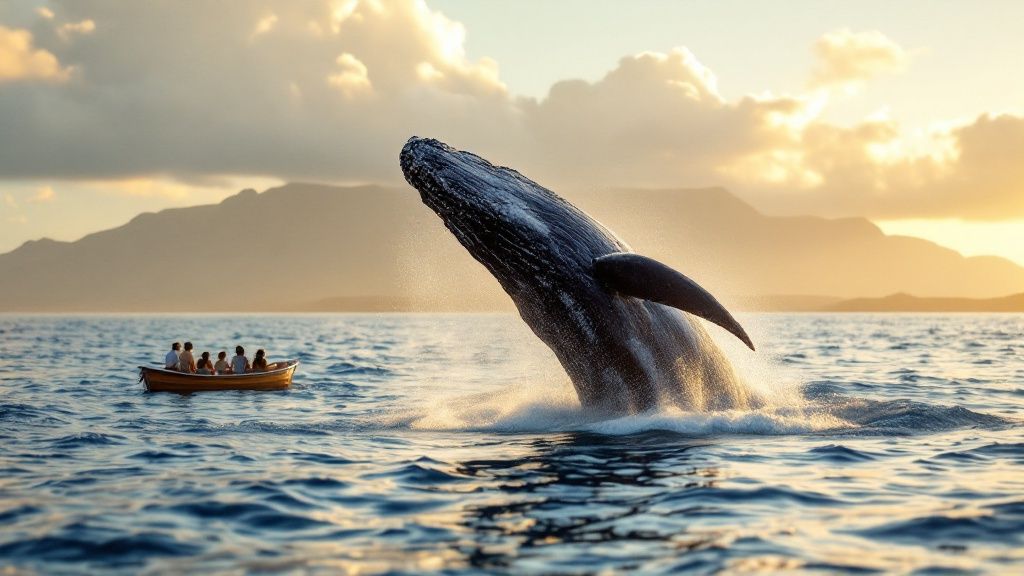
Every winter, something magical happens in the warm, tranquil waters surrounding Hawai‘i’s Big Island. The ocean transforms into a dynamic stage for one of nature’s most spectacular performances: the annual migration of thousands of North Pacific humpback whales.
Seeing these gentle giants in person is an experience that sticks with you. To make the most of it, you need to know the when, where, and why of this incredible phenomenon. That’s where we come in.
As Hawaii's top-rated and most-reviewed snorkel company, Kona Snorkel Trips is all about creating unforgettable marine wildlife encounters. Our reputation really speaks for itself.
Your Guide to Big Island Whale Watching
Timing is everything, but so is location. If you’re planning an adventure, you'll want a quick overview of the key details before diving in.
Here’s a quick rundown to get you started on planning the perfect trip.
Big Island Whale Watching At a Glance
| Factor | Details |
|---|---|
| Peak Season | January and February offer the highest concentration of whales. |
| Full Season | The entire season runs from late November through April. |
| Primary Location | The Kohala Coast (northwest side) is the undisputed hotspot. |
| Whale Species | North Pacific Humpback Whales are the main attraction. |
| Common Behaviors | Expect to see breaches, tail slaps, pectoral fin slaps, and spouts. |
With these basics in mind, you're already on your way to an incredible experience.
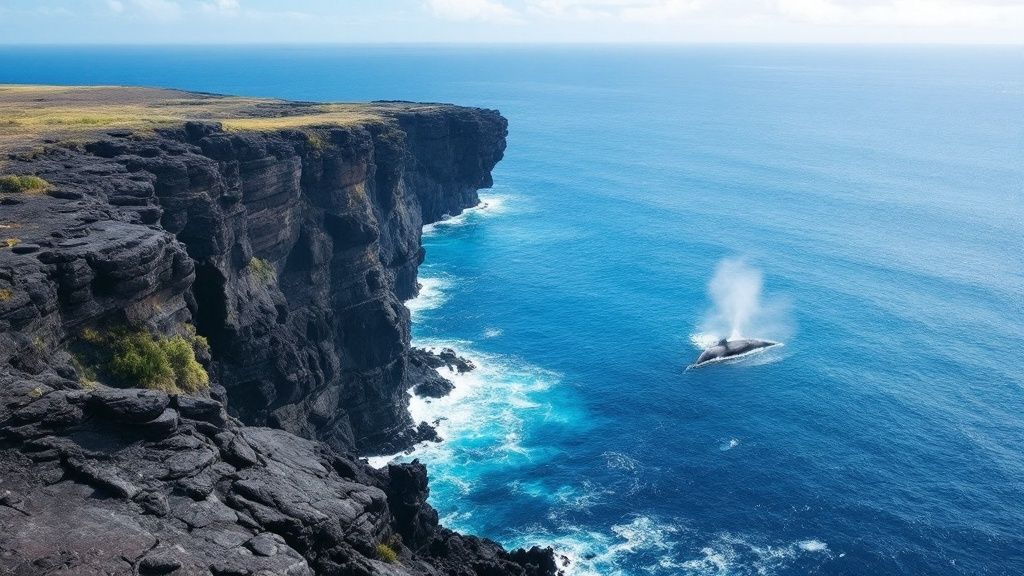
Why the Big Island Is a Whale Watching Haven
So, what makes the Big Island such a magnet for these majestic creatures? It really comes down to its unique underwater geography. Every winter, an estimated 10,000 humpback whales make the epic 3,000-mile journey from their chilly feeding grounds in Alaska.
They're seeking out Hawai‘i's warm, shallow, and protected waters—the perfect environment to breed, give birth, and nurse their newborn calves in safety.
The Kohala Coast, in particular, is whale central. This area consistently reports two to three times more sightings than other parts of the island. The reason? A perfect combination of deep offshore waters meeting shallower coastal shelves creates an ideal sanctuary that humpbacks just can't resist. You can learn more about the Big Island's prime whale watching conditions from our friends at lovebigisland.com.
This guide will walk you through everything you need to know to witness this natural wonder for yourself. From understanding the whales' incredible journey to choosing the right tour and watching them responsibly, you'll be ready for an adventure you'll never forget. Let's dive in.
The Incredible Journey of Humpback Whales
Every winter, something truly magical happens in the waters off the Big Island. It’s a massive family reunion, the final destination for thousands of North Pacific humpback whales after an epic 3,000-mile journey from Alaska.
This isn't just a casual swim south for the winter. It’s one of the most incredible migrations on the planet.
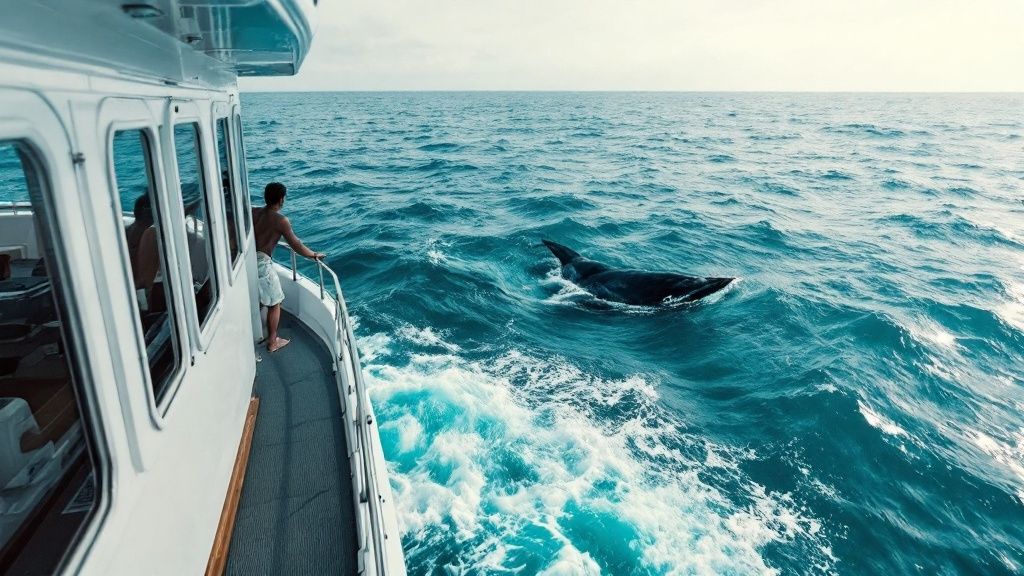
It all starts in the frigid, nutrient-packed waters up north. For months, these giants gorge themselves on krill and small fish, building up the massive fat reserves they'll need to power their long trip. This trek isn't a vacation; it's a pilgrimage driven by the single most powerful force in nature: the survival of their species.
A Nursery in Paradise
So why make this grueling journey? It all comes down to safety. While Alaska’s waters are a fantastic buffet, they’re also cold and full of predators like orcas—a terrifying place for a newborn whale.
Hawai‘i’s warm, clear, and relatively shallow waters are the perfect nursery. Pregnant females can give birth here, and new moms can nurse their young without constantly looking over their shoulders. It's an exhausting trip, but the payoff is peace of mind for the most vulnerable members of the pod.
"The humpback whales’ annual migration is a testament to their incredible resilience. They travel thousands of miles, fasting for the entire duration, all to ensure the next generation has a safe start in life in Hawaii's sheltered waters."
When the whales arrive, they have a few key things on their mind:
- Breeding: Males are ready to compete for mates, putting on incredible shows and singing complex songs that can travel for miles through the water.
- Birthing: Pregnant females find the calmest spots to deliver their calves, which already weigh around 2,000 pounds at birth.
- Nursing: A hungry calf can drink up to 100 gallons of its mother's extremely rich milk every single day, packing on the pounds for the return trip north.
Decoding Whale Behavior
When you're out on the water, you're not just watching animals swim by. You're seeing a complex social world unfold, with a language all its own.
Common Behaviors You Might See:
- Breach: This is the one everyone hopes for—a whale launching its entire body out of the water! Scientists think it could be a way to communicate, shake off parasites, or maybe just for the sheer fun of it.
- Tail Slap (Lobtailing): A powerful slap of the tail on the water's surface can be a warning to other whales or a way to send a message across a long distance.
- Pectoral Fin Slap: You'll see this when a whale is on its side, slapping its long fin against the water over and over. It's another form of communication you’ll often see in social groups.
- Spyhopping: Ever seen a whale poke its head straight out of the water? That's spyhopping. It's pure curiosity, as the whale gets a good look at what's happening above the surface.
Learning to spot these behaviors turns a whale watching trip into a real connection. You start to see the intelligence behind their actions. Thankfully, their numbers have made a remarkable comeback since the whaling days—a conservation success story we get to witness every year. You can learn more about how humpback whales' conservation status has changed in our related article.
This annual migration is the very heartbeat of Hawai‘i’s winter ocean, connecting the cold north with the warm tropics. It’s a powerful story of survival and renewal that you can see playing out right in front of you.
When And Where To See Whales On The Big Island
When it comes to whale watching big island style, it really boils down to two simple things: being in the right place at the right time. Think of it like a local surfer who just knows which swells will bring the best waves—if you plan your trip around the whales' annual migration, your chances for an incredible day on the water go way up.
The official season runs from December through April, but the real action is packed into the peak winter months.
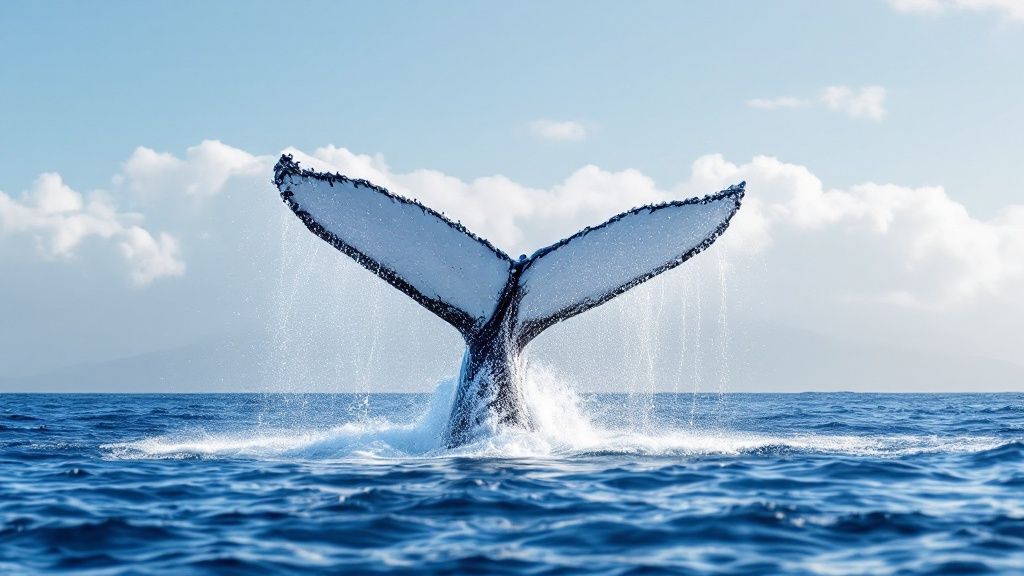
Pinpointing The Peak Whale Season
While the first humpbacks start showing up in November and a few stragglers hang around into May, the ocean is absolutely buzzing with activity in the dead of winter. It's like a massive family reunion—the best stories and most excitement happen when everyone is there.
- Peak Season (January & February): These two months are, without a doubt, the prime time. The whale population hits its absolute peak, which means more whales, more often. It’s pretty common to see multiple pods putting on a show during a single trip.
- Shoulder Season (December & March): You’ll still have a fantastic time, but the numbers are just building in December and starting to thin out in March. These months can be great for a slightly less crowded experience on the water.
- Late Season (April): This is the very tail end. You can still find whales, but you’re most likely to see moms with their newborn calves, as they are often the last to make the long trip back to their Alaskan feeding grounds.
To get a feel for what to expect month by month, here's a quick breakdown:
Whale Watching Season On The Big Island
| Month | Sighting Probability | Typical Activity |
|---|---|---|
| December | Good | Numbers are building. Early arrivals are establishing their presence. |
| January | Excellent | Peak season begins. High density of whales, frequent breaches and tail slaps. |
| February | Excellent | The absolute peak. Maximum number of whales, including competitive pods. |
| March | Good | Numbers start to decline as some whales begin their journey north. |
| April | Fair | Mostly mothers and calves. Slower-paced sightings, but very rewarding. |
| May | Low | Very few remaining whales. The season is effectively over. |
The data backs this up, showing that January and February are statistically the best months for whale encounters, particularly along the Kohala Coast. During this window, seeing three to six whales every 15 minutes from a good viewpoint isn't unusual. By March, those numbers often drop by about half.
The Best Spots For Sighting Whales
Not all Hawaiian coastlines are created equal in the eyes of a humpback. The Big Island’s west side is the place to be, and it all comes down to the unique underwater landscape that creates a perfect, safe nursery for mothers and their young.
The Kohala Coast: The Undisputed Hotspot
That entire stretch of coast from Kona north toward the tip of the island is what locals call "whale row," and for good reason. It offers calm, clear waters that are shielded from the powerful trade winds. The seafloor here is shallow near the shore before dropping off into deeper water, creating the ideal environment for whales to rest, nurse, and play without having to go too far out.
The protected waters of the Kohala Coast act as a massive, serene nursery for humpback whales. This geographical advantage makes it the most reliable and rewarding location for whale watching on the Big Island.
Other Promising Locations
While the Kohala Coast gets most of the glory, you can definitely catch the show from other spots, too.
- Kona Coast: The waters right off Kailua-Kona are also fantastic for sightings. With calm seas and great visibility, it’s a popular starting point for many whale watching tours.
- Hilo Side: You might get lucky and spot a whale off the eastern Hilo coast, but it’s far less common. The ocean is generally rougher and the weather more unpredictable, which makes for less frequent and reliable sightings than on the leeward side. For a deeper dive, check out our guide on the Big Island whale season.
The Best Time Of Day For Your Tour
Once you’ve got the right month and location locked in, the last piece of the puzzle is deciding what time to head out.
Hands down, early mornings are your best bet. The data shows that sightings are about 50% higher at 8:00 a.m. than they are at noon. The ocean is usually at its calmest, creating glassy conditions that make it way easier to spot spouts and breaches from a distance. Plus, calmer water means a smoother ride, so you can focus all your energy on the incredible spectacle in front of you.
Choosing Your Ideal Whale Watching Tour
Picking the right tour can absolutely make or break your whale watching adventure on the Big Island. Honestly, with so many options out there, the key is finding one that truly matches your style and what you hope to get out of the day. The kind of boat you're on, the experience of the crew, and the company's commitment to the whales' well-being all come together to create either a good day or an unforgettable one.
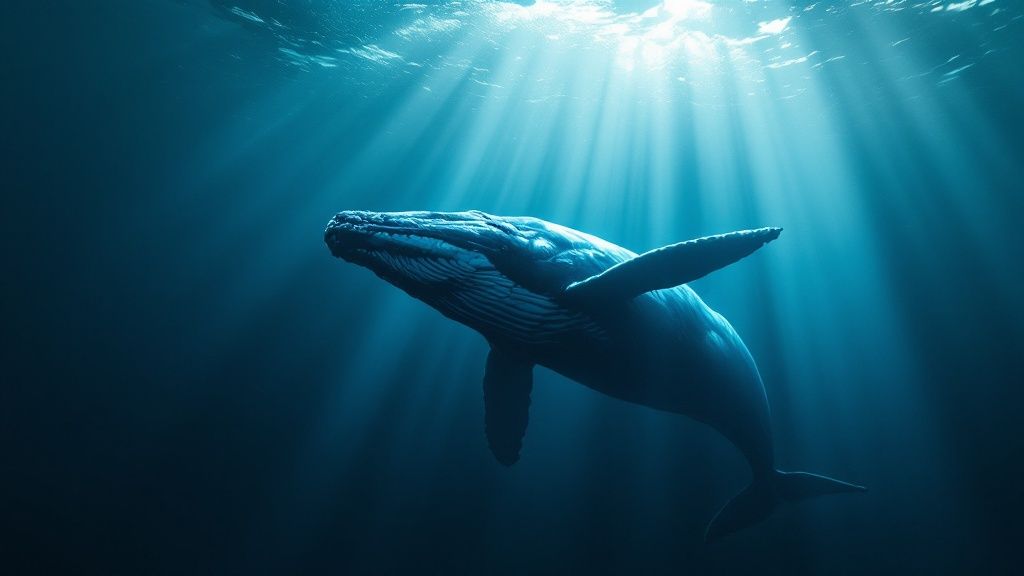
This decision is about so much more than just getting on a boat; it's about designing your own personal experience. Are you looking for the rock-solid stability of a bigger vessel, or do you crave the intimate, up-close feel of a smaller one? Is having a naturalist on board to explain what you're seeing a top priority? Let's dive into the options so you can make the perfect choice.
Comparing Different Tour Vessels
The boat you choose will fundamentally shape what you see and how you see it. Every type offers a completely different vibe—from comfort and amenities to how connected you feel to the ocean and its massive inhabitants.
1. Large Catamarans
Think of these as the gentle giants of the tour fleet. Their twin-hull design makes them exceptionally stable, which is a huge plus for families with kids or anyone who gets a little wobbly on the water. They're also likely to have creature comforts like restrooms and shady spots to relax.
- Pros: Super stable, plenty of space, and comfortable. They often come with onboard amenities.
- Cons: They can feel a bit crowded, and the higher deck means you're looking down on the action rather than being at water level.
2. Rigid-Hulled Inflatable Boats (Rafts)
If you've got a sense of adventure, a raft is your ticket to an exhilarating ride. These smaller boats are fast and nimble, and because you're sitting so low to the water, you get an incredible eye-level perspective that makes the whales seem even more massive. It's a real thrill.
- Pros: An exciting, fast-paced ride, intimate views, and the ability to zip over to new sightings quickly.
- Cons: Expect a bumpier trip with more exposure to sun and sea spray. They're not the best fit for anyone with back problems or for very young children.
3. Private Charters
For the ultimate, tailor-made day, nothing beats a private charter. You'll have the boat all to yourselves, giving you total freedom to follow your interests, whether that's photography, a special family celebration, or simply the desire for a quiet, personal encounter.
- Pros: Unmatched flexibility, personalized attention from the crew, and a private setting for your group.
- Cons: This is, understandably, the priciest option on a per-person basis.
What To Look For In a Reputable Company
The boat is only half the story; the company running it is just as important. A top-notch operator does more than just find whales—they cultivate an atmosphere of safety, respect, and education. You'll often find that companies with a great reputation for other marine tours, like Kona Snorkel Trips, bring that same high level of expertise to their whale watching trips.
Here’s a quick checklist for vetting tour companies:
- Experienced Naturalists on Board: A good guide is a game-changer. They turn a simple boat ride into a deep learning experience, explaining whale behaviors and sharing insights you'd never get on your own.
- Commitment to Ethical Viewing: This is non-negotiable. Responsible outfits strictly follow the federal and state laws requiring them to keep a distance of at least 100 yards from the whales. They always put the animals' well-being first.
- Excellent Safety Record: Your safety should be their number one priority. Look for companies with certified captains, well-maintained boats, and clear, professional safety briefings.
- Small Group Sizes: Smaller groups almost always mean a better experience. You get unobstructed views and more personal interaction with the crew and naturalist.
Choosing a tour with a smaller group size often leads to a more profound connection with the wildlife. With fewer distractions, you can fully immerse yourself in the moment and appreciate the sheer scale and grace of the humpback whales.
By thinking through both the type of vessel and the operator's reputation, you can confidently book a tour that fits your budget and sets you up for the perfect day on the water. For an even deeper dive into what to expect, check out our complete guide to whale watching tours in Kona, Hawaii.
How to Watch Whales Responsibly
There's nothing quite like seeing the sheer power and grace of a humpback whale launch itself out of the blue Hawaiian water. It’s an unforgettable privilege, and with that privilege comes a shared responsibility to protect these incredible animals. Responsible whale watching isn't just a nice-to-have; it's absolutely essential for ensuring the safety and well-being of the whales, letting them thrive in their winter sanctuary.
Think of it this way: observe, don't disturb. These whales have traveled thousands of miles to get here. For them, Hawai‘i is a place to breed, give birth, and nurse their young calves. This is a crucial and sensitive time, and getting too close can cause a lot of stress, especially for a new mom and her baby. By choosing to watch ethically, you become part of the solution.
Following the Rules of the Ocean
To keep the humpbacks safe, both federal and state laws are strictly enforced in Hawaiian waters. These aren’t just random rules; they're based on years of scientific research into whale behavior and are designed to minimize our impact. Any reputable tour operator will know these rules by heart and follow them without question.
The single most important rule to burn into your memory is the 100-yard minimum distance.
All vessels—boats, kayaks, paddleboards, you name it—have to stay at least 100 yards away from humpback whales at all times. Picture a football field; that's the kind of space they need to move, breathe, and interact without feeling cornered.
Getting too close can have serious consequences for the whales:
- Separating Mothers and Calves: A boat can easily get between a mom and her calf. For a young whale that depends entirely on its mother for food and protection, that's a life-threatening situation.
- Causing Stress: Loud engine noises and sudden movements can spook the whales, disrupting crucial behaviors like resting, nursing, or mating, often causing them to flee the area.
- Risking Collisions: Whales can surface without warning. Keeping a safe distance is the best way to prevent accidental and potentially fatal strikes.
On top of that, it's illegal to fly any aircraft, including drones, within 1,000 feet of humpback whales. These regulations create a "no-approach zone" that keeps both the whales and the whale watchers safe.
Supporting Conservation and Citizen Science
Protecting these gentle giants is a team effort that goes way beyond just the tour boats. Local conservation groups and citizen science programs are on the front lines, monitoring the whale population and helping us understand them better. When you support ethical tourism, you're directly contributing to these efforts.
One of the biggest local events is the annual whale count, a massive volunteer-powered effort to gather data. These counts give us a critical "snapshot" of whale numbers and where they're hanging out. For example, during a count on January 27, 2025, volunteers spotted an incredible 493 humpback whales from 30 shoreline sites around the Big Island—all within just a 15-minute window! You can learn more about these impressive whale count findings and see how this data helps track population trends over time.
By choosing a tour operator who's committed to doing things the right way, you’re supporting a sustainable industry that puts the well-being of marine life first. You become a steward of the ocean, helping ensure that future generations can experience the same awe-inspiring magic of whale watching on the Big Island.
Answering Your Whale Watching Questions
Even the most seasoned travelers have questions before heading out on the water. To make sure you feel totally ready for your Big Island whale watching adventure, we’ve put together answers to a few of the most common things we get asked.
What Should I Bring on a Whale Watching Tour?
Packing the right stuff can turn a good day into a great one. Hawaiian weather can flip on a dime, so it’s always smart to show up ready for a few different scenarios.
Here’s what we always tell our guests to bring for a comfortable trip:
- Sun Protection: That Hawaiian sun is no joke, especially when it’s bouncing off the water. Sunscreen, a good hat, and polarized sunglasses are non-negotiable.
- Camera and Binoculars: You’ll want to capture the magic, trust us. Binoculars are fantastic for getting a closer look at breaches and tail slaps without bothering the whales.
- Light Jacket or Windbreaker: It can be a warm day on shore, but once the boat gets moving, that ocean breeze can feel pretty chilly. A light layer makes all the difference.
- Motion Sickness Meds: If you even think you might get seasick, it's way better to take something before you leave the dock. You don't want to miss the show!
Can I See Whales From the Shore?
You absolutely can! While a boat tour gets you right into the heart of the action, you can definitely spot whales from land if you’ve got a little patience and know where to post up. A decent pair of binoculars is your best friend here.
One of the most reliable spots for land-based viewing is the Pu‘ukoholā Heiau National Historic Site up on the Kohala Coast. It sits up high, giving you a fantastic vantage point over the channel where the humpbacks love to hang out. You can also get lucky at many of the scenic overlooks along the Kona and Kohala coasts during peak season.
How Close Can We Get to the Whales?
This is a super important question, and the answer is all about respecting these incredible animals and their space. Federal and state laws are very clear: all boats must stay at least 100 yards away from humpback whales.
That 100-yard buffer isn't just a friendly suggestion—it’s the law. It’s a critical rule designed to protect the whales from stress and harm, especially when they're here for the sensitive business of breeding and raising their calves. Any reputable tour operator will stick to this rule without exception, because the whales' well-being always comes first.
Are Whale Sightings Guaranteed?
It’s the million-dollar question, isn't it? It’s crucial to remember we’re watching wild animals in their natural home. While sightings are incredibly common during the peak months of January and February, no honest captain can ever promise a sighting 100% of the time.
That said, experienced crews know the whales' favorite hangouts and daily patterns, which gives you the best possible shot at an amazing encounter. Many of the best companies will offer a "rain check" or a free trip if you don't see whales, which shows they're just as invested as you are in making it a great experience.
Ready to see these magnificent giants for yourself? At Kona Snorkel Trips, our crew lives for sharing safe, respectful, and completely unforgettable moments on the water.
Join us for a seasonal whale watching tour and make some memories that will stick with you for a lifetime.
